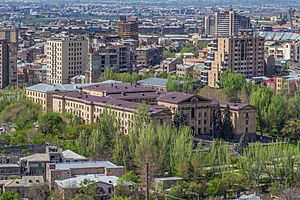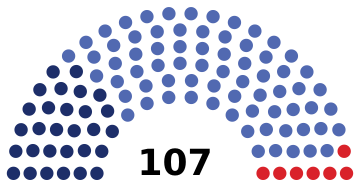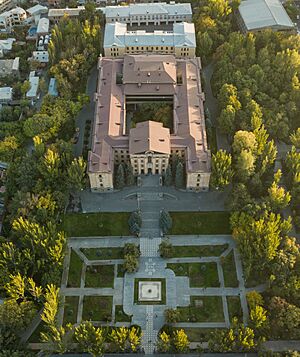National Assembly (Armenia) facts for kids
Quick facts for kids National AssemblyԱզգային ժողով |
|
|---|---|
| 8th convocation of the National Assembly | |
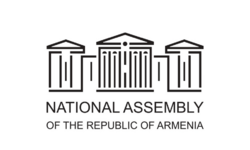 |
|
| Type | |
| Type | |
| History | |
| Founded | 1 August 1918, reestablished 5 July 1995 |
| Preceded by | Supreme Council of the Republic of Armenia |
| Leadership | |
|
President
|
Alen Simonyan, Civil Contract
Since 2 August 2021 |
| Structure | |
| Seats | 107 |
 |
|
|
Political groups
|
Government (69)
Opposition (36)
|
|
Length of term
|
5 years |
| Elections | |
| Two-round majority-minority jackpot system with a 5% threshold for parties and a 7% threshold for alliances | |
|
Last election
|
20 June 2021 |
|
Next election
|
2026 |
| Meeting place | |
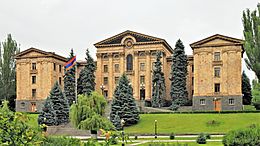 |
|
| National Assembly Building 19 Baghramyan Avenue Yerevan, 0095 Armenia |
|
| Website | |
| National Assembly of Armenia | |
The National Assembly of Armenia (which in Armenian is Azgayin Zhoghov) is also known as the Parliament of Armenia. It is the main law-making body of the government in Armenia. This means it is where new laws are discussed and approved for the country.
Contents
What is the National Assembly?
The National Assembly first started in 1918. It was called the Khorhurd back then. This happened after Armenia declared its independence. It acted as the temporary law-making group for the new nation.
After elections in 1919, more members joined the National Assembly. It had 80 members, including people from different minority groups. This group continued to work until Armenia became part of the Soviet Union in 1920.
From 1938, the National Assembly was called the Supreme Council of Armenia. After the Soviet Union ended in 1991, Armenia created a new Constitution in 1995. This led to the National Assembly we have today.
The National Assembly is a unicameral body. This means it has only one main group of members. It usually has at least 101 members. Sometimes, it can have more, up to about 200 members, but this is rare. The person in charge of the National Assembly is called the President. Currently, Alen Simonyan is the President.
How Members are Chosen
Members of the National Assembly are chosen through elections. People vote for political parties, not individual candidates directly. This system is called party list proportional representation.
- Four spots in the Assembly are saved for national minorities. These are people from smaller groups living in Armenia.
- To make sure there's a good mix, no more than 70% of the top people on a party's list can be of the same gender.
For a party to get seats in the National Assembly, it needs to win at least 5% of all the votes. If groups of parties (called alliances or blocs) join together, they need to win 7% of the votes.
The law says that at least three political groups must be in the parliament. Even if a party or alliance doesn't quite reach the 5% or 7% mark, the ones with the highest percentages will still get seats to make sure there are at least three groups.
If no party wins more than half of the seats in the first election round, and no group forms a strong alliance within six days, there will be a second round of elections. The two parties or alliances that did best in the first round can take part in this second round. The winner of the second round gets extra seats to make sure they have at least 54% of all the seats.
Leaders of the National Assembly
Over the years, many important people have led the National Assembly.
Speakers of the First Republic (1918–1920)
- Avetik Sahakyan (1918–1919)
- Avetis Aharonyan (1919–1920)
- Hovhannes Kajaznuni (1920)
Chairmen of the Supreme Council (1990–1995)
- Levon Ter-Petrosyan (1990–1991)
- Babken Ararktsyan (1991–1995)
Presidents of the National Assembly (1995–Present)
- Babken Ararktsyan (1995–1998)
- Khosrov Harutyunyan (1998–1999)
- Karen Demirchyan (1999)
- Armen Khachatryan (1999–2003)
- Artur Baghdasaryan (2003–2006)
- Tigran Torosyan (2006–2008)
- Hrayr Karapetyan (acting) (2008)
- Hovik Abrahamyan (2008–2011)
- Samvel Nikoyan (2011–2012)
- Hovik Abrahamyan (2012–2014)
- Galust Sahakyan (2014–2017)
- Ara Babloyan (2017–2019)
- Ararat Mirzoyan (2019–2021)
- Alen Simonyan (2021–present)
Vice-Presidents of the National Assembly
The Vice-Presidents help the President lead the National Assembly.
- Babken Ararktsyan (1990–1991)
- Gagik Harutyunyan (1990–1991)
- Ara Sahakian (1991–1998)
- Artashes Tumanyan (1991–1995)
- Karapet Rubinyan (1995–1998)
- Albert Bazeyan (1998–1999)
- Yuri Bakhshyan (1998–1999)
- Ruben Miroyan (1999)
- Gagik Aslanian (1999–2003)
- Tigran Torosyan (1999–2006)
- Vahan Hovhannisyan (2003–2008)
- Ishkhan Zakarian (2007)
- Arevik Petrosyan (2007–2010)
- Hrayr Karapetyan (2008–2009)
- Samvel Nikoyan (2009–2012)
- Samvel Balasanyan (2010–2012)
- Hermine Naghdalyan (2012–2017)
- Eduard Sharmazanov (2011–2019)
- Arpine Hovhannisyan (2017–2019)
- Mikayel Melkumyan (2017–2019)
- Alen Simonyan (2019–2021)
- Lena Nazaryan (2019–2021)
- Vahe Enfiajyan (2019–2021)
- Ruben Rubinyan (2021–present)
- Hakob Arshakyan (2021–present)
Latest Election Results (2021)
The most recent election for the National Assembly was on June 20, 2021. Here's how the political parties did:
Committees: How the Assembly Works
The National Assembly has different groups called committees. These committees help the Assembly do its work by focusing on specific topics.
Standing Committees
There are eleven main committees that work all the time:
- Defense and Security
- Economic Affairs
- European Integration (working with Europe)
- Financial and Budgeting Affairs (money matters)
- Foreign Relations (working with other countries)
- Health Care and Social Affairs (health and community help)
- Human Rights and Public Affairs (people's rights)
- Science, Education, Culture, Diaspora, Youth and Sport
- State and Legal Affairs (laws and government rules)
- Territorial Administration, Local Self-Government, Agriculture and Environment (local areas, farming, and nature)
- Territorial Integration
Special Committees for Specific Tasks
Sometimes, the National Assembly creates special committees for certain jobs. These are called temporary or inquiry committees.
- Temporary committees are set up to discuss new laws or ideas. They give their thoughts to the main Assembly.
- Inquiry committees are formed if at least 25% of the members ask for one. Their job is to look into important public issues and find facts. They can ask government groups and officials for information, as long as it's not a secret protected by law.
One example of a special committee was the Committee on Ethics. This committee checks if members of the Assembly follow the rules, like not doing other paid jobs that could cause a conflict of interest. They also make sure members are respectful and follow moral rules. If someone thinks a member broke a rule, they can tell this committee. The committee then looks into the issue and makes a decision.
Another special committee was formed in 2014 to study the gas supply system in Armenia. It looked at things like gas prices and how consumers were protected. This committee gathered information and presented its findings to the National Assembly.
Working with Other Countries
The National Assembly of Armenia works with parliaments in many other countries. This helps them share ideas and work together on important issues. Some of the countries they cooperate with include:
- Georgia
- France
- Egypt
- Russia
- Kyrgyzstan
- Syria
- Lebanon
The National Assembly is also part of many international groups that bring parliaments together. These groups include:
- NATO Parliamentary Assembly
- EU-Armenia Parliamentary Partnership Committee
- Interparliamentary Assembly on Orthodoxy
- Inter-Parliamentary Union
- Parliamentary Assembly of the Organization of the Black Sea Economic Cooperation
- Parliamentary Assembly of the Collective Security Treaty Organization
- Parliamentary Assembly of the Council of Europe
- Euronest Parliamentary Assembly
- Assemblée parlementaire de la Francophonie
- Parliamentary Assembly of the Organization for Security and Co-operation in Europe
- CIS Interparliamentary Assembly
- ASEAN Inter-Parliamentary Assembly (as an observer)
See also
 In Spanish: Asamblea Nacional de Armenia para niños
In Spanish: Asamblea Nacional de Armenia para niños
- Elections in Armenia
- List of legislatures by country
- List of political parties in Armenia
- National Assembly of Artsakh
- Politics of Armenia
- President of the National Assembly of Armenia
- Programs of political parties in Armenia


